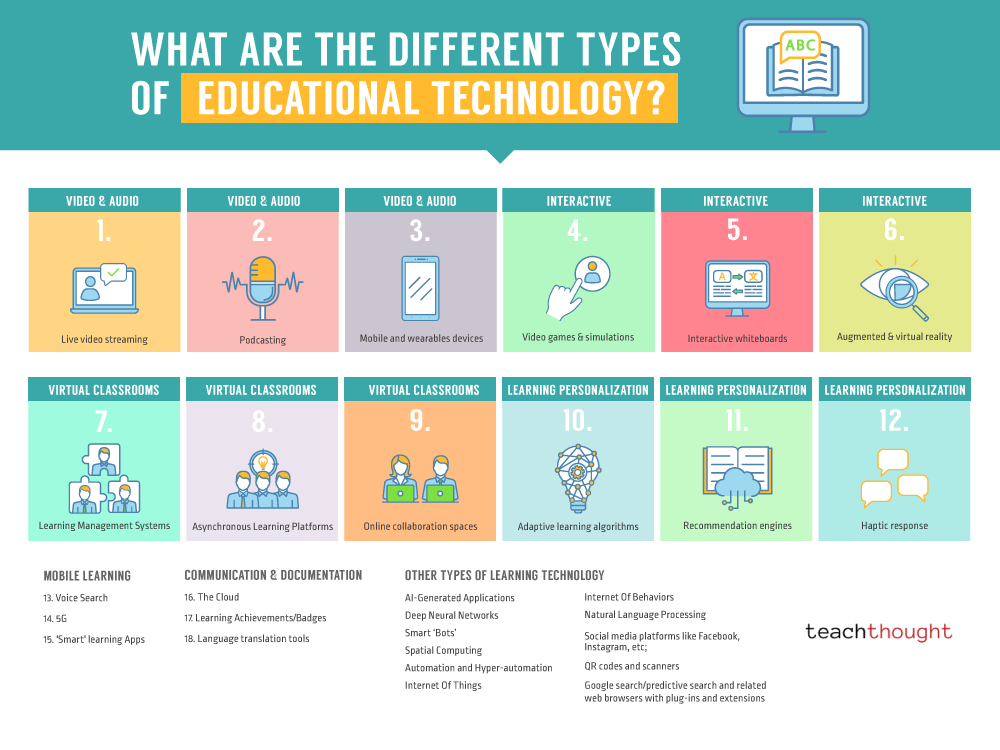
What Are Examples Of Learning Technology?
by Terry Heick
This is a sponsored post. You can read more about our sponsored content policy here.
The goal of this post is simple: To provide examples of learning technology–identifying and clarifying what learning technology ‘is’ and ‘looks like’ in and out of the classroom.
I actually started this post in 2015 and thought it might be useful for some, so I updated and finished it. A few frequently asked questions for context:
What is the simple definition of technology?
We tend to think of ‘technology’ as new–and usually computer hardware or software of some kind. This is only one kind of technology.
More broadly, a simple definition of technology is the application of ‘things’ (often knowledge) that cause change. This ‘change’ can be in the form of the development of science, the solving of problems, producing commercial goods, improving healthcare, sharing information, altering physical landscapes, creating physical and digital structures, and so on.
Definitions vary from dictionary to philosophical to conceptual and so on. For our purposes, we will define ‘technology’ as the application of tools, knowledge, processes, or other methods of attaining objectives.
See also 4 Examples Of Technology In The Special Education Classroom
In terms of its timeliness, ‘technology’ is also a relative term. At one point, a pencil was considered ‘new’ technology. In sociocultural contexts, it is also relative as technology that might be nearly invisible in one society could completely change (for better or for worse) another society. Meaning is contextual, and so is technology as a concept.
What is education technology for teaching and learning?
Education technology is the application of new tools and ideas that help teachers teach and students learn.
What are the functions of education technology?
Education technology can automate processes, improve information access, enable sharing of knowledge and data, duplicate information between media forms, curate important knowledge, communicate ideas, visualize critical concepts, and more.
(To be fair, technology can also destroy, poison, obliterate, mislead, etc., but this is more a criticism of applied technology rather than the concept of technology itself.)
What words are related to technology?
To understand technology as a concept, it might be useful to look at some related words: technique, technical, technician, technological, technically, technocracy, and technophile
The root of technology is Greek: Tekhne (art, craft) and -logia.
What are learning technologies in the classroom?
Learning technologies in the classroom are the tools, systems, and techniques that facilitate, enable, and promote learning.
This can happen in the form of a learning management system or platform like the Khan Academy that helps students practice new skills, a community-based ‘encyclopedia’ like Wikipedia that allows people to curate and share knowledge, interactive whiteboards that allows students to learn through guided practice with the teacher. Learning technology can be simple (like a calculator) or advanced (like virtual reality).
What are the different types of educational technology?
Learning Achievements/Badges
Podcasting
Gamification
Video Games
Interactive Whiteboards (e.g., Google Jamboard)
Learning Management Systems (Moodle, Google Classroom, etc.)
Asynchronous Learning Platforms (often a part of learning management systems but not always)
Online collaboration spaces (e.g., Microsoft Teams)
The Cloud
Adaptive Learning Algorithms
Voice Search
Haptic Response
Blockchain
Augmented Reality
Virtual Reality
5G
AI-Generated Applications
Deep Neural Networks
Smart ‘Bots’
Spatial Computing
Automation and Hyperautomation
Internet Of Things
Internet Of Behaviors
Natural Language Processing
Software
Hardware
Apps
social media platforms like facebook, Instagram, math programs, etc;
YouTube
live video streaming platforms (from YouTube or Twitch for video games to streaming public events to Strategies For Using TikTok For Learning for learning)
Google Chromebooks, MacBooks, Windows laptops
iPads and Android tablets
Apple Watch and other smartwatches and wearable technology; virtual reality hardware, applications, and games; QR codes and scanners; Google search and related web browsers with plug-ins and extensions; adaptive learning algorithms and artificial intelligence; Kindles and other eReaders; projectors; USB and portable memory; cloud storage and file-sharing; smart boards; document scanners; personal computer desktops and Mac Minis (as a portable desktop); operating systems like Mac OS, iOS, Android, Microsoft Windows), video games, message forums; MOOCs; podcasting tools; crowdsourcing platforms
Other Less ‘Visible’ Examples Of Technology In Education
Of course, not all ‘technology’ is hardware or software. If technology is the application of tools, systems, and knowledge in order to meet an objective, the examples of learning technology really open up.
Microsoft AZ-400 Practice Tests Dumps
Curriculum mapping: the gathering, organizing, and intentional distribution of knowledge
Assessment: the attempt to measure a student’s understanding or mastery of content or skills. In this sense, the function of technology is to make something abstract (understanding) concrete (a letter or number). In this case, the effect of the educational technology is quantification and qualification.
The concept of public education: the intent to educate all citizens through the transformation of text dollars into edifices (schools) and systems (districts, classes, schedules, etc.) that help children learn
A Socratic Seminar: a system for learning through guided inquiry and discussion
Other examples: Parent-Teacher conferences, school schedules, report cards, the organization of classrooms by age, the categorization of knowledge and skill into ‘content areas,’ and even school electricity, and plumbing.
